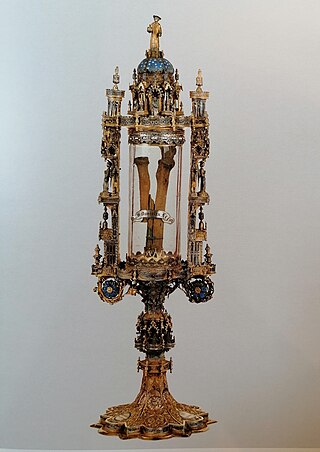
Saints Faith, Hope, and Charity , are a group of Christian martyred saints who are venerated together with their mother, Sophia ("Wisdom").
In the Western Church of the Early and High Middle Ages, a sacramentary was a book used for liturgical services and the mass by a bishop or priest. Sacramentaries include only the words spoken or sung by him, unlike the missals of later centuries that include all the texts of the mass whether read by the bishop, priest, or others. Also, sacramentaries, unlike missals, include texts for services other than the mass such as ordinations, the consecration of a church or altar, exorcisms, and blessings, all of which were later included in Pontificals and Rituals instead.

Saint Geminianus was a fourth-century deacon who became Bishop of Modena. He is mentioned in the year 390, when he participated in a council called by Saint Ambrose in Milan. From his name, it has been deduced that Geminianus probably belonged to the caste of Roman senators.
Alban of Mainz was a Catholic priest, missionary, and martyr in the Late Roman Empire. He is venerated as Saint Alban of Mainz in the Catholic Church, not to be confused with Saint Alban of Verulamium.

According to legend, Rufinus of Assisi, was the first bishop of this city and a martyr.

Trieste Cathedral, dedicated to Saint Justus, is a Roman Catholic cathedral and the main church of Trieste, on the Istrian peninsula in northeastern Italy. It is the seat of the Bishop of Trieste.
Cathedral of San Giusto can refer to one of the following religious buildings in Italy:

Susa Cathedral is a Catholic cathedral in Susa, Piedmont, in northern Italy. It is the seat of the Bishop of Susa and is dedicated to Saint Justus of Novalesa.

Saint Caesarius of Terracina was a Christian martyr. The church of San Cesareo in Palatio in Rome bears his name. He is venerated as a saint in the Eastern Orthodox Church and Roman Catholic Church, with a feast day on 1 November.

Verona Cathedral is a Roman Catholic cathedral in Verona, northern Italy, dedicated to the Blessed Virgin Mary under the designation Santa Maria Matricolare. It is the episcopal seat of the Diocese of Verona.

Saint Germanus of Granfelden was the first abbot of Moutier-Grandval Abbey. He is venerated as a martyr saint in the Catholic and Eastern Orthodox Churches.
Saint Edistus is venerated as a martyr and saint by the Roman Catholic and Eastern Orthodox churches. His legend states that he was martyred on the Via Laurentina and his passio places his martyrdom during the reign of Nero, on October 12, 60 AD.

Saint Cetteus is the patron saint of Pescara. He was a bishop of the 6th century, elected to the see of Amiternum in Sabina in 590, during the pontificate of Gregory the Great.

The Diocese of San Jose de Antique is a diocese of the Roman Rite of the Latin Church of the Catholic Church whose cathedral is in the municipality of San Jose de Buenavista, Antique in the Philippines. It oversees the entire province of Antique.
The Abbey of San Giusto is a former Cistercian monastery located in the valley of the river Marta approximately 4 km south of Tuscania, Province of Viterbo, Italy.

Luxurius or Luxorius was an ancient Roman official on Sardinia in the late 3rd and early 4th centuries. Apparitor to Delphius, the praeses or governor of the island, he was converted to Christianity by reading the Psalms. He possibly was beheaded on 21 August for refusing to sacrifice to idols in the city of Forum Traiani, probably in 304 during the fourth of Diocletian's persecutions. Later he was venerated as a martyr and saint by the Roman Catholic Church.

Carlo Wostry was an Italian painter and illustrator.

The Reliquary of Saint Daniel is a liturgical object that comes from the Cathedral Church of Padua. This object was created by Bartolomeo da Bologna, Antonio di Giovanni and Francesco di Comino before 1472. It is now preserved in the Diocesan Museum in Padua, as part of its collection. The reliquary displays the relics of Saint Daniel, a 4th century Paduan martyr whose body is preserved in the Cathedral Church of the city.












